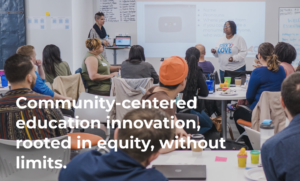Building the Future: Designing With Purpose

As Getting Smart’s Director of Coaching, I find relevance in the application of design thinking to multiple aspects of my life, whether in formal or informal learning environments. My most recent “aha” moment was delivered by the purchase of a “new” old home. The home is located close to our kids’ schools and family, with a price that was affordable, but it had been unoccupied for a period that exceeded 5 years—during which time it received minimal maintenance by the property management group that had been tasked with upkeep.
As we went through the remodel of this home, I was met with an exciting collision of relevance and crossover with my professional passion of designing innovative learning experiences. While there is a great deal of stress associated with completely remodeling a home (just like with expanding opportunities to provide learners and whole systems with innovative change), there is also a great deal of “pride of ownership” around the journey and delivered outcome. There are a handful of other relevant connections which, once I found the courage to take them on, provided a great opportunity to grow and learn. My translated insights are outlined below.

Be clear on your “why.”
First things first. In all aspects of design, it is important to spend time discovering your “why”. As provided in Simon Sinek’s nationally recognized best seller, Start with Why, “Finding WHY is a process of discovery, not invention.” Spend time with all stakeholders (family in this life scenario) and emphasize the “who” that will be served within the design you are creating. Be confident in continuously revisiting your why and know that it will evolve with the process. Your why is the living, breathing nucleus for each decision that you and your team will make.
As a family, we identified values and non-negotiables that set the stage for our house hunting journey. Once clear on why we were moving and why we wanted the things that we established on our list, we found that our search looked very different. It no longer relied on highlights motivated by other people’s interests and drastically changed the landscape of our search. This is extremely relevant in school and program design. We at Getting Smart are huge advocates of researching and, whenever possible, visiting other schools and programs as you craft your design (see 100 Middle Schools & High Schools worth visiting), but we also emphasize the importance of using your why and the community that you serve as your design filter.

Frame: Check the foundation.
In design, it is critical to frame the opportunity. Identify strengths and weaknesses with an outcome target of student growth and amplified opportunities for students to learn how to learn—the foundation must be solid. Examine the foundation for cracks and then begin to the frame the “walls.” Walls establish the parameters, and are often represented by the descending highlights of 30,000 ft. vision—from takeoff all the way to landing. It has a clearly established start and end point, even if it is represented by a series of starts and finishes (think land, refuel, take off and repeat).
Ideate: Shop around and figure out what you like and don’t like.
I have vivid memories of when I was growing up, and teachers would say that “the only bad question is the one you do not ask.” I would now echo that same sentiment for the ideation phase of design. The only bad idea is the one that you do not share. During this phase of the design, it is important to capture every single idea, and be intentional about soliciting ideas from all stakeholders involved. One Stone students in Boise, ID have this dialed down to science. They call it “51-ing it,” and have been intentional in arming students with the skills to fearlessly deliver ideas with a confident swagger that is rooted in shared respect for the philosophy that the only bad idea is the one that is not shared. We partnered in delivering an LX Summit this spring, and success feedback of the 2-day experience was continuously rooted in the power that student leadership and voice can have through the open sharing of their ideas where there is no fear holding back the sharing of a potentially brilliant idea.

Create: Find contractors that share your vision.
As you have now successfully framed and gathered ideas around your design, it is time identify strategic thought partners that support deeper learning. In looking at what you would like to create, figure out who shares your vision and can increase your capacity to create. In my favorite book of all time (a lofty statement, as I am an avid reader—which could be its own blog in terms of preparing your mind and soul for innovative design), The Adventures of Johnny Bunko: The Last Career Guide You’ll Ever Need, by Daniel Pink, he takes Johnny through 6 lessons, with number 2 delivered as “Think Strengths, not weaknesses.”
While sound advice in every aspect of life, it is extremely relevant as you begin to create and add people to the design team. Don’t focus on what they have not done, focus on their strengths that are in alignment with the frame and the complement of the culture within your team.


Execute: Don’t set the doors before the floors.
So you have framed, taken a thorough dive into the world of ideation, and created the design (version 1.0), and it is time to execute (or in the words of Seth Godin, “Ship it”). I have adopted this term, highlighted in Poke the Box, which Godin originally used to describe product development and the importance of delivery to market. Its relevance in our approach to this phase of the design framework is grounded in understanding urgency while balancing a strategic blueprint that leads to the sustainable execution of the design.
Iterate: Keep the end in sight, but be prepared for the day-to-day.
Arguably the most important part of this ever-evolving process is the continued assessment of the design, in which we note potential improvements, adjustments, modifications and adaptations. This process is guided by the voice of each student, and reflective practices that provide springboards and adjustments to the road map that is design thinking.
Change is hard, and change is personal, and if you and your team have determined that change is needed to design learning experiences that prepare students for the future, then stay the course and celebrate the iteration of your design. In Derek Sivers’ Anything You Want, he shares a quote that resonates on the growing confidence in celebrating milestones large and small. “If you think your life’s purpose needs to hit you like a lightning bolt, you’ll overlook the little day-to-day things that fascinate you.” As you iterate and reiterate the design, pay attention to things that fascinate you.
 With design thinking, there is a deep connection to learning for life through living life.
With design thinking, there is a deep connection to learning for life through living life.
Our Getting Smart Services team continually strives to develop partnerships with individuals and organizations focused on personalizing education for each and every learner. As a learning design firm, we apply a solution mindset to accelerate impact-focused opportunities to design and deliver innovative change. We are strategic in applying our Smart Design Framework to transform learning, and pride ourselves on leading future forward initiatives that redefine and reinvent learner experiences. If you would like a deeper learning partner to expand your ability to dream, design and deliver, or additional details on our Smart Start coaching opportunities, contact Adam Kulaas, Director of Coaching, at [email protected].
For more, see:
- Why We Advocate for Equity and Access Through Personalized Schools and…
- Rethinking Middle School with Design Thinking at Vista Innovation & Design…
- Design Thinking: Teaching the Importance of Empathy in Business
Stay in-the-know with all things EdTech and innovations in learning by signing up to receive the weekly Smart Update. This post includes mentions of a Getting Smart partner. For a full list of partners, affiliate organizations and all other disclosures please see our Partner page.







Jordan Schleider
Outstanding Article! Thanks for sharing the great insights.